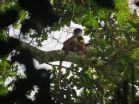(Press-News.org) How does climate change affect the occurrence and distribution of species? This is a key question in the climate debate, and one that is hard to answer without information about natural variation in species abundance. Now researchers from Uppsala University can, for the first time, give us a detailed picture of natural variation through a major study published today in the leading scientific journal Current Biology.
The impact of climate change on species occurrence and distribution is a central issue in the climate debate, since human influence on the climate risks posing threats to biodiversity. But until now methods for investigating how natural climate variation in the past has affected the abundance of species have been lacking.
Now, for the first time, Krystyna Nadachowska-Brzyska and Hans Ellegren of Uppsala University's Evolutionary Biology Centre in collaboration with researchers at the Beijing Genomics Institute, have managed to clarify the issue in detail by analysing the whole genome of some 40 bird species. By studying the genetic variation of DNA molecules, they have succeeded in estimating how common these species were at various points in time, from several million years ago to historical times.
Ellegren says: 'The majority of all species exhibit cyclical swings in numbers and these swings often coincide with the periods of ice ages.'
During the Quaternary Period (the past two million years, including the Pleistocene epoch, i.e. up to some 11,500 years ago), inland ice periodically spread across large land areas of Earth. Species distribution then became compressed with falling numbers of individuals as a result. When the climate became milder and the ice sheets retreated, many species expanded.
Rising and falling species numbers thus seem to result naturally from climate variation. Nevertheless, Ellegren warns of the effects of human influence on the environments in which many birds live, and in the long term on the climate as well.
'The last Ice Age (110,000-12,000 years ago) had a particularly heavy impact on birds. Many species suffered their most dramatic falls in numbers then.'
Accordingly, there is a risk of the relatively recent influence exerted by human beings on environments and habitats, and of course the climate, having a particularly adverse effect on species that have already 'declined'. Anthropogenic impact may therefore be what irrevocably pushes their decline beyond the 'tipping point' to eventual extinction.
'We've analysed several species classified as "endangered" in the IUCN Red List of Threatened Species. Several, such as the crested ibis, crowned crane, brown mesite and kea, were already at a low level even before human activities affected their ranges,' says Ellegren.
The survey, which is based on advanced mathematical calculations of how many individuals of each species have existed at different periods, yielding the genetic variation in the genome that is now observable, is the most extensive of its kind to date.
INFORMATION:
The nutrients excreted by fish in their "pee" may be critical to the health of coastal ecosystems. But knowing whether generalizations can be made about how to predict these nutrient levels in various ecosystems has vexed researchers - until now.
In a paper published in Proceedings of the National Academy of Sciences, North Carolina State University associate professor Craig Layman and colleagues show that ecologists can better predict the rates of how these chemical nutrients are transferred by fish if they know the various fish species living in an ecosystem, along ...
An international team of scientists, led by researchers at University of California, San Diego School of Medicine, have found genetic overlap between Alzheimer's disease (AD) and two significant cardiovascular disease risk factors: high levels of inflammatory C-reactive protein (CRP) and plasma lipids or fats. The findings, based upon genome-wide association studies involving hundreds of thousands of individuals, suggest the two cardiovascular phenotypes play a role in AD risk - and perhaps offer a new avenue for potentially delaying disease progression.
The findings ...
A potentially game-changing breakthrough in artificial photosynthesis has been achieved with the development of a system that can capture carbon dioxide emissions before they are vented into the atmosphere and then, powered by solar energy, convert that carbon dioxide into valuable chemical products, including biodegradable plastics, pharmaceutical drugs and even liquid fuels.
Scientists with the U.S. Department of Energy (DOE)'s Lawrence Berkeley National Laboratory (Berkeley Lab) and the University of California (UC) Berkeley have created a hybrid system of semiconducting ...
CORVALLIS, Ore. - A national survey suggests that slightly more than half of the older adults in the United States are now taking a daily dose of aspirin, even though its use is not recommended by the Food and Drug Administration for most people who have not yet had a heart attack or stroke.
The analysis was published today in the American Journal of Preventive Medicine. It observed that aspirin use is continuing to surge, especially among adults who are using it for "primary prevention," meaning in order to prevent an initial cardiovascular event, and in some cases to ...
The psychological impact and private agony of infertility must be carefully considered by healthcare professionals, suggests a new review, published today (Friday 10 April) in The Obstetrician & Gynaecologist (TOG). The review identifies infertility as a complex state and life crisis and sets out the dangers of neglecting the emotional impact of involuntary childlessness and viewing it solely in biological or medical terms.1
The article provides an introduction to infertility counselling in the UK, within the context of fertility treatment. This includes an explanation ...
Analysis of the longer-term influence of menopausal hormone therapy on breast cancer incidence in two Women's Health Initiative (WHI) clinical trials suggests a pattern of changing influences over time on breast cancer, according to an article published online by JAMA Oncology.
Use of menopausal hormone therapy decreased dramatically after reports of increased breast cancer risk with estrogen plus progestin from the WHI randomized clinical trial followed by the Million Women Study observational analysis. Following the initial WHI reports, decreases in both combined estrogen ...
Obesity was associated with an increased risk for prostate cancer in African American men and that risk grew by nearly four times as body-mass index (BMI) increased, according to an article published online by JAMA Oncology.
African American men have the highest incidence of prostate cancer of any racial or ethnic group in the United States, as well as the highest rates of aggressive disease and prostate cancer death. These elevated risks likely arise from both social and biologic factors. The associations of obesity with prostate cancer risk are complex.
Wendy E. Barrington, ...
Advice on preventing and treating venous thromboembolism (VTE) during pregnancy, birth and following delivery is outlined in two new revised guidelines published today (13 April) by the Royal College of Obstetricians and Gynaecologists (RCOG) and launched at the RCOG World Congress in Brisbane, Australia.
VTE refers to the formation of a clot within veins. This can occur anywhere in the venous system, but the predominant sites are in the vessels of the leg (giving rise to deep vein thrombosis (DVT)) and in the lungs (resulting in a pulmonary embolism (PE)).
The Green-top ...
Two primatologists working in the forests of the Republic of Congo have returned from the field with a noteworthy prize: the first-ever photograph of the Bouvier's red colobus monkey, a rare primate not seen for more than half a century and suspected to be extinct by some, according to WCS (the Wildlife Conservation Society).
The elusive primate was recently photographed by independent researchers Lieven Devreese and Gaël Elie Gnondo Gobolo within Ntokou-Pikounda National Park, a 4,572-square-kilometer (1,765-square-mile) protected area created on advice from WCS ...
COLUMBIA, Mo. - Discussing end-of-life wishes with loved ones can be difficult, but new research from the University of Missouri shows more individuals are engaging in advance care planning. Advance care planning includes discussing end-of-life care preferences, providing written end-of-life care instructions and appointing a durable power of attorney for health care.
"Advance care planning increases the likelihood that the care one receives at the end of her life is congruent with what she wants," said lead author Nidhi Khosla, an assistant professor of health sciences ...


